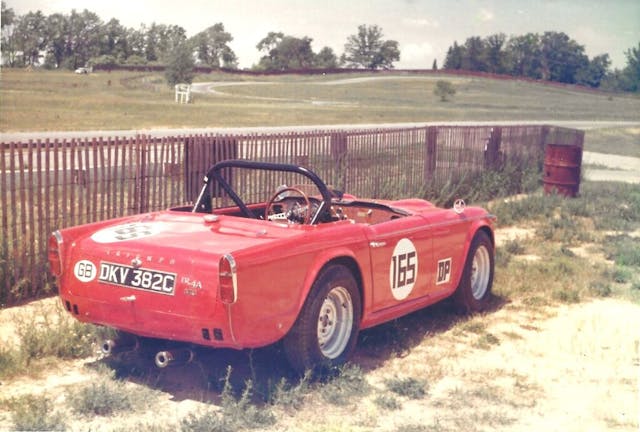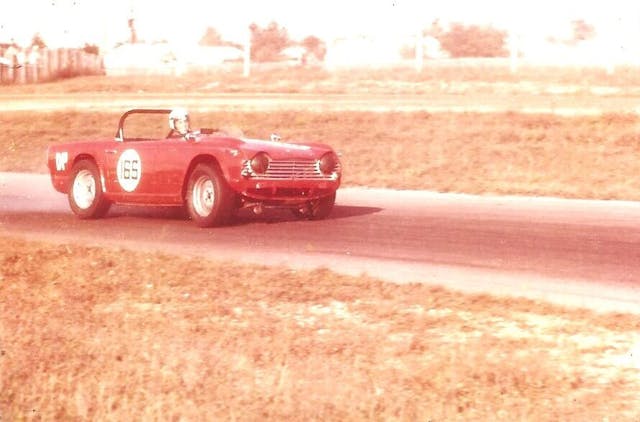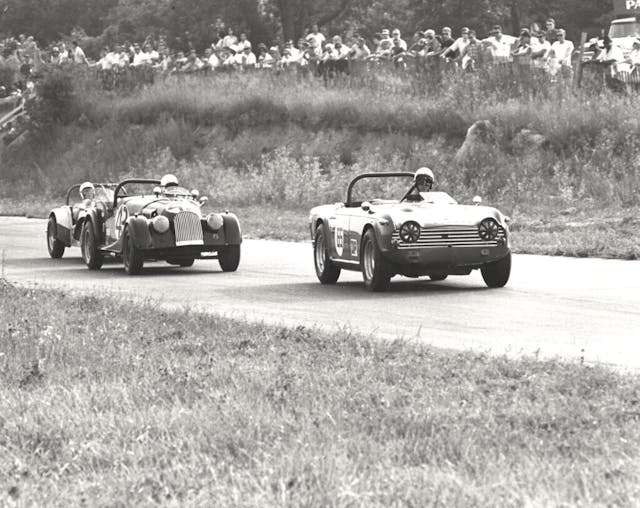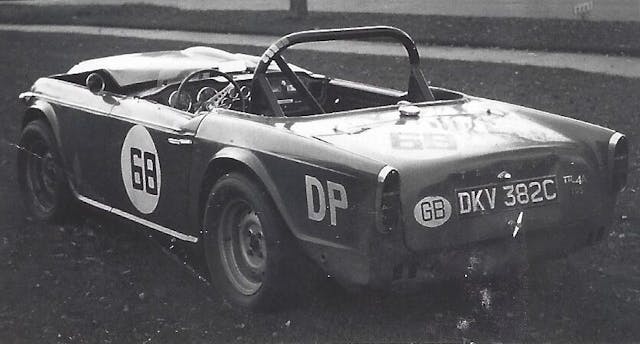The Special Life of a Very Special Car, Ch. II: Let’s go racing
Some stories are too good and long to tell (or read) in just one installment, so here is the tale of this remarkable car’s three very different phases of life in my hands in three logical segments. Chap. I finds it hustling around a couple of famed European F1 racetracks and touring as far north as Stockholm, Sweden, and even into then-divided Berlin, Germany.
Chapter II sees it taking me faithfully through SCCA driving school and my first semi-successful season of amateur racing, book-ended by two unfortunate crashes, one on the road, the other in its season-ending race.
Chapter III, “Anchors Aweigh,” is available here. —GW
The road was straight, flat, and very dark. I was returning to my motel late and tired, after failing to locate a Saturday night party to which I had been invited by a woman I had met earlier. I was in Northern Ontario, Canada, in January 1966, on a ski trip with my talented-skier friend and roommate Frank. I was driving my 1966 Triumph TR4A, which I had bought soon after my college graduation in 1965, picked up in England, and driven around Europe—and on a couple of its famed F1 racetracks—that September.
Its (tractor-derived) torquey 2138-cc four-cylinder thrummed happily at speed, and the car surged eagerly forward as I pulled out and passed a slower driver (the only other vehicle out there at that time) at probably 80 mph. Then, back on the straight two-lane heading rapidly toward town, I must have dozed briefly at the wheel.
I opened my eyes just in time to see a 90-degree right turn rushing toward me. Naively hoping that the Triumph and its fine-handling Michelin X radials could take most any curve at most any speed, I eased on the brakes and turned into the curve—way too fast. The back end came around. I steered left to catch the slide, back right to avoid over-correcting, and—suddenly—the world went dark. I had accidentally hit the headlamp stalk, on the left side of the steering wheel, and turned off the lights.
Spinning to my right, and no longer able to see where to aim the car, I decided to let it spin around backwards. Better to go off the road backward, even if I hit something, rather than forward. The car slid off into a roadside ditch, tail first, and began a slow roll. I grabbed the bottom of the wheel, ducked down, and tried to make myself small as it rolled one and a quarter times, coming to rest on my driver’s side.
Thanks largely to the Sears seatbelt I had bought, installed, and habitually used since taking delivery, I was uninjured. However, I was trapped. My door had opened and twisted around into the left front fender as the car slid backward on its side. My left leg had somehow flopped out and was pinned. No amount of pushing on the ground would flip the car back on its wheels or move it enough to free my leg. With my left side on the ground, I suddenly felt cold and exposed in the Northern Ontario winter air and began to think about the potential of fire.
The Triumph was still running, so I reached up and turned off the ignition. As I did so, I heard a car going by. I flashed my lights to attract its attention—nothing. Things were not looking good. But then I heard a car approach from the other direction, and it stopped. Two men ran over and asked if I was okay. I said yes, but my leg was trapped. Could they move the car enough to set me free? They hoisted it back onto its wheels, and I was up and out.
My rescuers were the drivers of the car that I had passed at speed. They told me that, when I accelerated past them, they had joked that either I was Stirling Moss (really!) or that I would likely be off the road by the time they caught up with me. And they were right on the latter. The right-hander that had caught me out was known locally as Dead Man’s Curve, because so many folks had driven straight off it into the trees and died.
Since they were nice people, they called the local police and stayed with me until the officers arrived. The cops asked a few questions, determined that I was not drunk, and decided not to issue a ticket. They knew that deadly corner well and were grateful that I was okay. Then they drove me to my motel—where Frank was fast asleep—and assured me that my Triumph would be retrieved and delivered there in the morning.
I fell asleep wondering how I could have been so stupid to have crashed, yet grateful that I had been smart enough to have installed and worn that seatbelt. Without it, I very likely would have been pitched out as the car rolled, and it would have landed on top of me. I also credit the strength of the TR4A’s windshield frame, and my decision to let the car spin around backward, since it was bent up and to the right instead of collapsing onto me as it might have had the car been moving forward while rolling. (Sure glad it wasn’t an old TR3, or the MGB or Austin Healey I had also considered!)
I awoke the next morning hoping that I had dreamed the whole thing. But the dirt I dug out of both ears assured me otherwise. The crash had really happened. I broke the news to Frank, who agreed that, after Sunday’s skiing, we would have to drive the banged-up Triumph home, with its windshield and side windows gone, its top in shreds, its driver’s door crumpled, and its bumpers mangled, among other things. And with no working radio, either: When I went back to look at the scene the next day, I found the junkyard radio I had installed in the glovebox several feet away in a snowbank.
That drive home in the dark was a nightmare. We wired the driver’s door semi-shut, so the passenger door was our only way in and out, and quickly found that our front wheels wobbled like those of a bad shopping cart above 35 mph. With no windshield or windows and the Triumph’s weak (optional) heater, we nearly froze. We wore ski masks that Frank had brought. Mine was white, so it looked like my head was bandaged from the wreck we had obviously suffered. Stopping several times to warm up and quaff hot coffee on our slow, cold journey, we drew quite a few sorry looks. When we finally reached the border checkpoint, the guards asked if we had driven the car into Canada in that condition. I said no, only on the way back.
Drivers’ schools

I had sold the old Ford wagon that had gotten me through my senior year in college, so I needed to quickly find an affordable daily driver. I chose a 1961 Chevy Impala, which was much more acceptable in Chevrolet Engineering employee parking than my Triumph, which had attracted grumbles from loyal Chevy workers.
With Frank’s help, I got the Triumph to my local dealer for repairs. Thankfully, my insurance covered most of the bill, and I was able to redirect some of that money away from the purchase of new bumpers and toward installation of a roll bar, since the Triumph was destined to become my first SCCA race car. No need for bumpers on a race car, right? It was supposed to have gotten that roll bar installed the week before the ski trip, but my dealership technician in Royal Oak, Michigan, had delayed that job due to other pressing business.

Finally, with the Triumph (almost) good as new and running well, I took it to the May 1966 SCCA driver’s school at nearby Waterford, Michigan, a small but challenging 1.5-mile track. Still stock (minus bumpers) and rolling on its OE Michelins, it performed well as I learned the lines of the track through its tricky curves and its few short straights. The only two other cars in my D-Production class were an MGB and a (new to the U.S.) Porsche 911. During the short race that concluded the school’s itinerary, I easily passed and pulled away from the MGB, then caught the 911, but I could never get past it: With more power than me but tricky handling, that damned Porsche held me up through every turn, then blew me away down every straight. I developed a strong dislike for 911s and was delighted to see them moved up to the faster C-Production class the following year.
My second SCCA-required school was at (the now defunct) Lynndale Farms Raceway, a 2.5-mile course 20 miles west of Milwaukee, Wisconsin. No drama there, except my instructor yelling at me for driving one-handed past the pits during a Saturday practice with my left arm leaning casually on the window ledge like I was cruising Woodward. Well, I was tired, hadn’t had much sleep on the way there, and the long front straight was a boring slog in a bone-stock Triumph. With more cars in my class, most of them race-prepped, I managed a fourth-place finish in the concluding race. Not bad.
Racing at last

With my SCCA Regional license in hand, I ran one Waterford Hills club event and one Regional at Waterford, scoring second in one heat race and fifth in both main events. Unable to afford both slick racing tires and treaded rain ones, I opted for a set of Dunlop “universals,” which were not especially good in the dry or in the wet but were a step up from the narrow radials fit by the factory.
I also decided the Triumph needed a set of racing shocks. Unfortunately, the nearest place I could find the lever-type performance rear dampers I wanted was a dealership across the river from Detroit in Windsor, Ontario, Canada. I actually drove the Triumph over there, through border checks both ways, with only the UK license plate on it and no U.S.-legal registration. Then I bought and installed an (SCCA-legal) higher-performance camshaft.
A July trip to a Regional at Nelson Ledges in Northeastern Ohio yielded a decent fourth-place finish. And I was really starting to have fun! As the saying goes, the most fun I’ve had with clothes on.
Serious setback

Back at Waterford for a club event the following week, on the first lap of my first heat race, the Triumph suddenly shed its left rear wheel in a tight right turn cresting a hill and slid off to the left, up against a fence. The body damage was minor, but I was done for the weekend. The left rear axle had twisted off, and I had no spare. I thought my friend Bob Dorn, a fellow Chevy engineer and winning racer who had been prepping a TR4A for serious SCCA National racing, might have one. I knew he had taken it to a Mid-Ohio National for its first outing and should be home sometime Sunday evening, so I drove to his house and waited outside.
When Bob finally arrived, he had neither a spare axle nor much sympathy for me. His beautifully prepared, new Triumph had been running very well until it, too, had shed its left-rear wheel, in the fast right-hand turn at the end of Mid-Ohio’s long back straight. Because he had exited the corner far faster than I had—and sideways—his car flipped multiple times, side to side and end over end. He pulled into the driveway with his TR4A crinkled up into a sorry ball on his trailer. At 6 feet, 4 inches, Dorn was lucky to have survived that crash, and it ended his racing aspirations. Instead, he concentrated on his GM career and eventually worked his way up to chief engineer at Pontiac, then Cadillac Division.
Since I was flat-towing the Triumph to races behind my Chevy with a cobbled-up tow bar, I needed it back on all four wheels to get it back to my parents’ house in an East-side Cleveland suburb, where I was staying during a training assignment at Chevy’s nearby transmission plant. Very few TR4As had been sold in my area as of mid-1966, but I was lucky to find a crashed one at a Detroit junkyard. I pulled off its left rear axle, then drove back to Waterford to install it. I ended up missing just one day of work.
Thoroughly pissed that the same potentially fatal failure had happened to both Dorn and me, I wrote a passionate letter to U.S. Triumph racing guru Kas Kastner. He agreed to send me a couple of heat-treated axles, which were much stronger than the stock ones. Once received, I immediately installed them. The good news was that Bob sold me his four remaining Goodyear slicks, an upgrade that instantly moved me from the middle to near the front of my class.
The rest of the season yielded a disappointing sixth at Grattan, Michigan (with some sort of steering issue, probably caused by the “off” at Waterford), followed by a more satisfying third at Lynndale Farms. Then I was back at Waterford for what turned out to be my best racing weekend of the year: I won a Saturday novice race, which qualified me for that day’s “sprint” race. I placed third, then managed to win the DP feature race on Sunday. Not bad!
Season-ending crash

Meanwhile, with the Vietnam war raging, I decided to join the Navy Reserve and was accepted to Officer Candidate School (OCS) in Newport, Rhode Island, that fall. My last race of the season would be an October Regional at Mid-Ohio, and since I had finally admitted to my parents that I was racing the Triumph, I invited them to drive down and watch. I was running fairly well until a car ahead of me, that I was trying to pass, spun in front of me. A car behind me that I had just passed ran into my Triumph from behind and pushed me head-on into the spinning car. My folks saw the whole thing.
The rear damage was minimal but the front damage substantial, and I had to get the car repaired and back on the road ASAP to drive it to Newport for OCS. My dad, bless his soul, loaned me money for the repairs. My mom admitted that she felt better about my racing after seeing me jump out of the crashed car angry but unhurt, and I was soon off to Navy service.
***
Check out the Hagerty Media homepage so you don’t miss a single story, or better yet, bookmark it. To get our best stories delivered right to your inbox, subscribe to our newsletters.



I am digging this story a lot. Anyone who has ever raced in SCCA can certainly relate to the pretty-much-brushed-off descriptions of damage from the more or less minor “shunts”, because they realize that if your race, you will break and/or crash, and the only thing to do is fix it and try to make the next week’s event. There were almost no original body panels left on my 911 by the time it retired from racing 🙄.
Gary tells a good story!
He sent you a heat-treated axle? That’s awesome. I feel like now they’d ignore it. I can’t imagine a personal response like that
Waterford Hills hasn’t changed a bit since those days…. 😆
Question: as a teen going to SCCA races at Vineland Raceway in Jersey and Reading in PA, a very famous and fast Triumph TR 4 driver, Dick Stockton was our hero. He had a shop near the Phila area. Perchance does anyone else remember him and whatever happened to him?
Hello Lon. About 15 tears ago I know Dick Stockton had gotten his black TR4 back on track for some vintage races. At the time he had a shop in Bally PA Triumph Rescue working on it. Not sure if he is still around but I’m sure TR Rescue would know.
Dick got his old TR4 back in 2002 and vintage raced it for the next 15 years or so, and was the fastest TR4 in any field by a longshot when it stayed together. He’s 90 now and no longer racing.
You can see more at http://www.the71crowd.com . Dick was very successful with a SCCA BP 289 Cobra and IMSA Toyota’s as well.
Love the story. Looking forward to Part 3!
Great story. While I never raced, I worked many SCCA races as a corner flagger/fire putter-outer so got to see these things up close and personal. Even chased–for a quarter mile–an errant TR3 wheel that parted company from its car during a race at the long defunct Austin Raceway Park. And timed Hap Sharp’s Chaparral during my stint during the 1965 Sebring 12 hour race. Lotsa great memories!
Great story and I’m looking forward to the next installment! Had a friend who raced a ‘78 Datsun 280Z in SCCA’s ITS class back in the late 90’s. My son and I were his “pit crew”. We didn’t race ourselves but we experienced the passion and camaraderie among drivers/owners and their willingness to share parts and experience. Yes, terrific memories!
Having had a National Chief’s Licence in Timing & Scoring I used to work most of the races at Nelson Ledges and the Nationals at Mid-Ohio and the Can-Am’s in the 60’s, & 70’s. I also had a ’67 TR4A which I dearly loved & wish I still had. So this was and is a great story that brought back many fond memories.
This is a very enjoyable story. Just this week I unearthed and scanned a couple dozen 35mm slides of my trip to Nelson Ledges in the spring of 1968. They were terrible (most of my slides from college days were awful) but it sure brought back the memories (including all the mud). I still pine for cars of that era.
It is hard to fathom that you rolled the Triumph in Canada and then you were able to drive it home. How is this possible? Wow — incredible!
It was a slow roll, very thankfully. Damage was mostly to body, top and suspension, not to structure or powertrain.